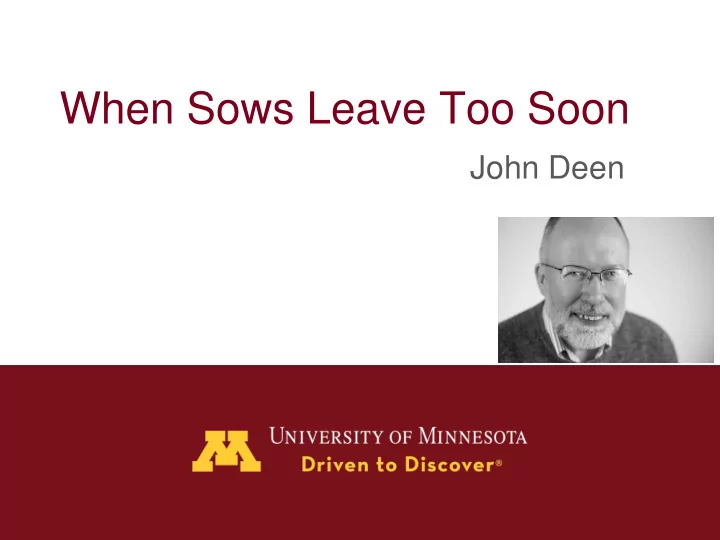

When Sows Leave Too Soon John Deen
Sow Attrition 100 80 60 Proportion Surviving 40 20 0 0 1 2 3 4 5 6 Parity
When you are up to your neck in alligators , it's hard to remember the original objective was to drain the swamp…
Is the sow coping? • Behavior: interactions with floor, air, other sows, inflammation, feed and water • Pathology: injuries, inflammatory responses, fever • Productivity : culling, NPD’s, litter size, litter survival and carcass composition
Why did the sow die? • Because it couldn’t cope with challenges • Because it wasn’t culled • Because it farrowed • Because it had reproductive priorities • Because it has longevity risks • Unpredictable – Sudden, eg prolapses • Predictable – Chronic, eg lameness – Usually a combination of factors, eg heat, lameness and feed intake
Farrowing Crates • Approximately 2.6% of sows died before leaving the farrowing crate • Approximately 61% of the total mortality is in the periparturient period • The daily risk of mortality is approximately seven times higher during this timeframe
Risk post farrowing P r o p o r t i o n o f M o r t a l 20 15 10 5 0 0 15 30 45 60 75 90 105 120 135 150 165 180 Days after farrowing
Odds of removal vs one day off feed 2.5 2 Odds of Removal 1.5 1 0.5 0 0 0.5 1 1.5 2 2.5 3 3.5 Feed Intake for the Day (Kg)
Seasonality M o r t a l i t y R a t e ( % 14 13 12 11 10 J F M A M J J A S O N D Month
Muggy in Minnesota: State is setting summer records for heat and humidity Neighbor to the north hoards its cool air as Minnesota swelters. By John Reinan Star Tribune JULY 14, 2018 — 6:25PM “Overnight low temperatures since June 1 have averaged 62.1 degrees, the hottest nighttime temperatures ever. That’s two degrees higher than in 2012, which ranked second .”
Stillbirths 14 12 Rate/Parity Record 10 8 6 4 2 0 1 2 3 4 5 6 7+ Stillbirths/litter
Live Long and Prosper
Other Risk factors • Lameness. Sows that enter the farrowing crate lame had a 40% higher odds of dying • Acclimatizing to the farrowing crate, when controlling for gestation length, had no effect • Backfat. Sow condition scores were a better predictor of mortality than back fat. • Obstetrical interventions and duration of farrowing, when controlling for stillbirths, did not have an effect
Hiding Behavior During Feeding lame non- total lame During lame 15 1 16 movement to non- 9 23 32 farrowing lame total 24 24 48
Lameness effects Decreased salvage value $4.28 Increased replacement costs $36.00 Decreased output $121.05 Decreased value of output $9.00 Total $170.34
Predictors of breeding group mortality rates • Average parity sows – +0.9% per parity • Gilt pool size at weaning – -0.3% per 1% of herd inventory • Number of sows – -.04% per 1% of herd inventory
What major risk should sows avoid to avoid mortality? – Pregnancy • What one thing should sows do to avoid culling? – Get pregnant • Do we know the accuracy of culling? – Is culling always successful?
Successful culls • At planned productive age • Without predictive productivity failure • Without welfare concerns • At full sale value • At weaning • With a replacement ready – Less than 10% in most herds
Unsuccessful culls • To avoid mortality/morbidity – lameness • To avoid poor productivity – Prior reproductive history – Usually an underlying pathology – Often an inflammation, eg claws • Culling in error – When replacements (and their progeny) don’t do better on average
Steps towards improving survivability • Prioritize pathology over productivity in retention • Improve conformation to reduce pathology • Record problems and follow sows: – Lameness – Off-feed events – Treatments: antibiotics and anti-inflammatories • Evaluate culling strategies
Recommend
More recommend